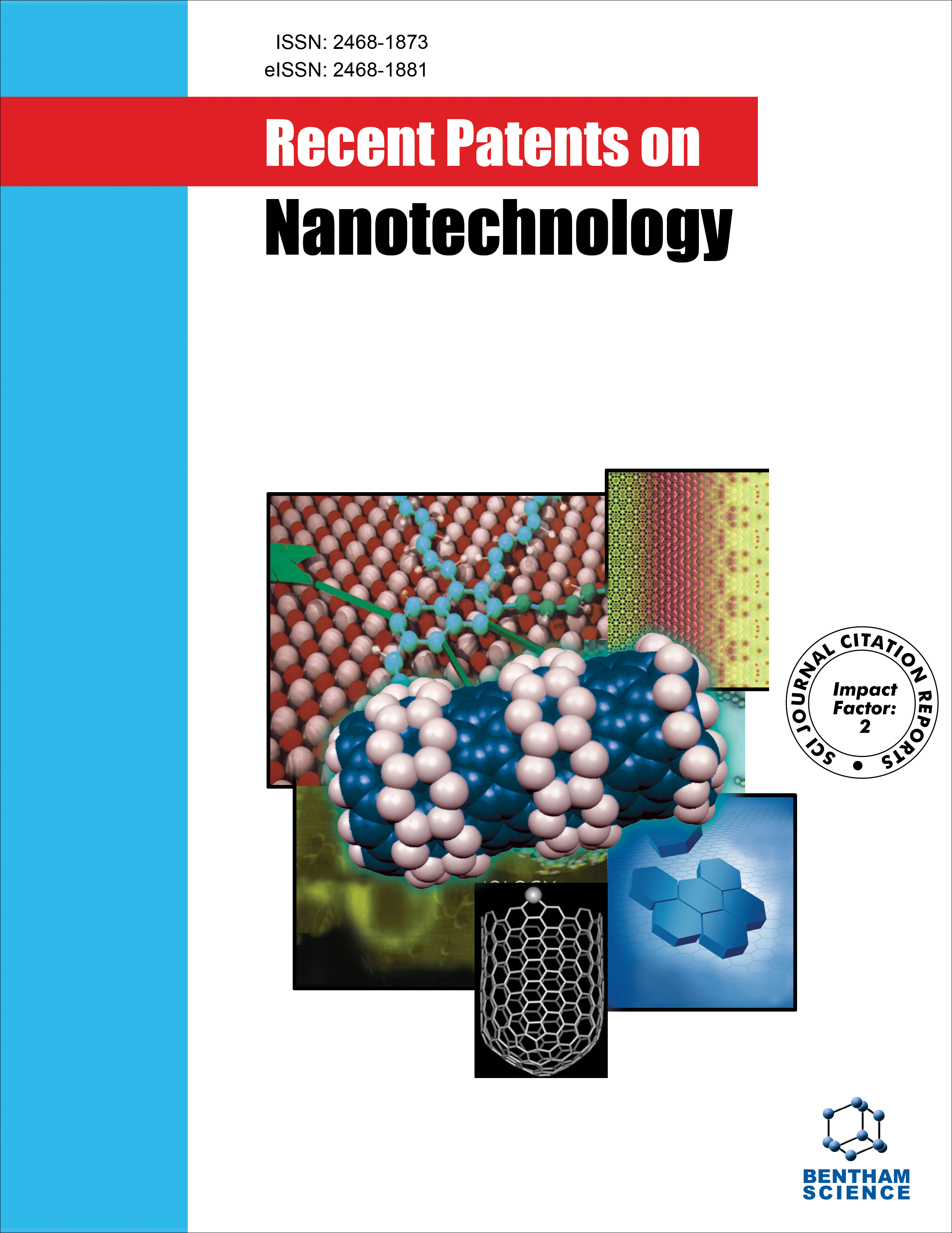- Home
- A-Z Publications
- Recent Patents on Nanotechnology
- Previous Issues
- Volume 17, Issue 2, 2023
Recent Patents on Nanotechnology - Volume 17, Issue 2, 2023
Volume 17, Issue 2, 2023
-
-
Nanosponges- Versatile Platform as Drug Carrier
More LessBackground: Recently, nano-drug delivery systems have become an integral part of the most novel drug delivery systems and have gained considerable importance owing to various advantages such as carriers for poorly soluble drugs, targeting molecules at the desired site, protection from degradation etc. Objective: One of the most studied areas of nanotechnology is nanosponges. The objective of this review was to e Read More
-
-
-
Nanomaterial Gas Sensors for Biosensing Applications: A Review
More LessBy KurmendraBackground: Nanomaterial is one of the most used materials for various gas sensing applications to detect toxic gases, human breath, and other specific gas sensing. One of the most important applications of nanomaterial based gas sensors is biosensing applications. In this review article, the gas sensors for biosensing are discussed on the basis of crystalline structure and different categories of nanomaterial. Methods: In this p Read More
-
-
-
Synthesis, Characterization, and Antibacterial Properties of ZnO Nanostructures Functionalized Flexible Carbon Fibers
More LessAuthors: Ahmet Aykaç and Emine Özge AkkaşBackground: Studies on the surface functionalization of flexible carbon fibers without any substrate by using cost-effective, fast, and practical processes that may provide antibacterial properties to carbon fiber have received great importance recently. Objective: The objective of this patent study is to obtain zinc oxide nanostructures functionalized carbon fibers by a facile, cheap, fast, and repeatable method, and to show th Read More
-
-
-
Development and Characterization of Polymeric Microsponge as a New Vehicle to Deliver Urea Topically
More LessAuthors: Lalit Kumar, Rahul Kumar, Syed B. Hussain, Shivali Kumari and Yash PalBackground: Topical delivery of therapeutic agents is considered beneficial due to various advantages like ease of administration, avoidance of the first-pass effect, and improved patient compliance. Therefore, scientists around the globe are exploring this route for the delivery of drugs nowadays. Objective: The present patent investigation aimed to prepare, optimize, and characterize the urealoaded microsponges for e Read More
-
-
-
Preparation of Bismuth Tungstate/Preoxidized Acrylonitrile/Acrylic Acid Copolymer Composite Nanofiber Membrane and Its Photocatalytic Properties
More LessAuthors: Yinchun Fang, Xinhua Liu, Hongzhang Li and Yanchun LiuBackground: In this patent article, a novel bismuth tungstate/preoxidized acrylonitrile/ acrylic acid (AN/AA) copolymer composite nanofiber membrane was prepared, which was used as the visible light catalyst. Methods: AN/AA copolymer was synthesized, which was electrospun with bismuth nitrate and sodium tungstate to prepare the composite nanofiber. Then the composite nanofiber was preoxidized to prepare th Read More
-
-
-
Effects of Coupled-/soluble-Copper, Generating from Copper-doped Titanium Dioxide Nanotubes on Cell Response
More LessAuthors: Pengyu Gao, Xiao Luo, Benli Yin, Zhisha Jiao, JunJi Piao, Ansha Zhao and Ping YangBackground: Endothelialization in vitro is a very common method for surface modification of cardiovascular materials. However, mature endothelial cells are not suitable because of the difficulty in obtaining and immunogenicity. Methods: In this patent work, we determined the appropriate amount of copper by constructing a copper- loaded titanium dioxide nanotube array that can catalyze the release of nitric oxide, compa Read More
-
-
-
Controlled Growth of Indium Oxide Nanowires for Gas Sensing Application
More LessAuthors: Dang Ngoc Son, Nguyen Van Duy and Nguyen Duc HoaBackground: The In2O3 nanowires have attracted enormous attention for gas sensor application due to their advantageous features. However, the controlled synthesis of In2O3 nanowires for gas sensors is vital and challenging because the gas sensing performance of the nanowires is strongly dependent on their characteristics. Methods: Here in this patent, we fabricated In2O3 nanowires on SiO2/Si substrate via a simple therm Read More
-
-
-
Copper and Zinc Co-doped Titanium Dioxide Nanotubes Arrays on Controlling Nitric Oxide Releasing and Regulating the Inflammatory Responses for Cardiovascular Biomaterials
More LessAuthors: Benli Yin, Xiao Luo, Peng Y. Gao, Zhi Sha Jiao, Jun Ji Piao, An Sha Zhao and Ping YangBackground: Titanium dioxide (TiO2) nanotubes arrays have shown tremendous application foreground due to their unique characters of structure and performance. However, the single bio-function is still the limit on cardiovascular biomaterials. Methods: The loadability function provides the possibility for the TiO2 nanotubes arrays to realize composite multifunction. The copper can catalyze the release of nitric oxide to prom Read More
-
Volumes & issues
-
Volume 19 (2025)
-
Volume 18 (2024)
-
Volume 17 (2023)
-
Volume 16 (2022)
-
Volume 15 (2021)
-
Volume 14 (2020)
-
Volume 13 (2019)
-
Volume 12 (2018)
-
Volume 11 (2017)
-
Volume 10 (2016)
-
Volume 9 (2015)
-
Volume 8 (2014)
-
Volume 7 (2013)
-
Volume 6 (2012)
-
Volume 5 (2011)
-
Volume 4 (2010)
-
Volume 3 (2009)
-
Volume 2 (2008)
-
Volume 1 (2007)
Most Read This Month
Article
content/journals/nanotec
Journal
10
5
false
en


